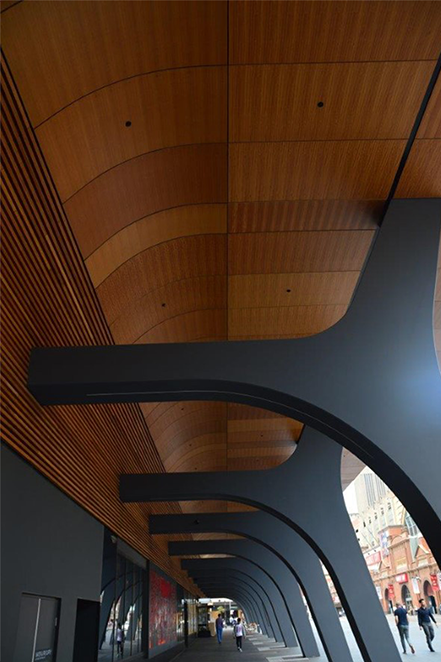30—06—2021
Curved Plywood: How it’s Made and Why it Can Take Your Design to the Next Level
One of the (many) things we love about ply is its versatility. A simple plywood panel can be turned into endless shapes, sizes and colours, and can be used for a huge range of purposes.
While timber in architecture and interior design is most commonly used to create straight lines, these days there is plenty of interest in curved design features too. Curves mimic the forms of nature more closely and can change the look and feel of a design dramatically, creating visual interest and a distinctly different feel to straight edges. Our plywood can be bended to create curved panels, and our Darling Square project is a great example of this. The curved panels give the busy walkway in Sydney’s CBD a real sense of flow and style that is the ideal fit for the space.
There are two distinct methods that are commonly used to create curves in plywood panels – kerf bending and layering multiple sheets. We explain how both bending methods work in more detail below.
Kerf bending
This method of bending wood requires no machinery to create the curve, which makes it a popular choice. It involves making a series of cuts into one side of the ply board, which leaves room to compress the sheet into the space made by the cuts. When pressure is applied, it is possible to create a curve in the timber, while also maintaining the plywood’s original or recommended thickness. After the desired curve is achieved, the panel is generally covered by a plywood sheet to achieve a seamless finish.
Kerf bending is ideal for plywood for joinery, and our in-house manufacturing team can apply this method on request for any curved timber required for your project. It’s important to note that kerf bending requires a minimum radius of 300mm and it is not recommended for structural timber as the cuts have an impact on the strength of the wood.
Layering multiple sheets
A simple way to achieve the same aesthetic look across your project where curves are required can be to layer and bond multiple thin sheets of ply together. A key benefit of this method is that you can easily complete it on site, by bending the plywood layers around an existing wall structure. Because this method forms around a tighter radius, you can build the thickness to match the surrounding walls, creating an even finish that is durable and resistant to moisture. It’s also possible to layer across large spans and form a range of shapes, resulting in a flawless finish that is sure to impress.
Make a statement with curved ply
Curved plywood provides architects and specifiers with another avenue for creating unique and showstopping designs. From bold sweeping curves that cover large spaces to the finer details of a curvy piece of furniture or joinery, there’s something about curved timber that elevates a design to the next level. We can’t wait to see more projects incorporate this stunning feature into their design!
If you have a question about curved ply, please get in touch to discuss your project requirements. Our team are always happy to assist! Simply get in touch on 1300 761 741.

30—06—2021
One of the (many) things we love about ply is its versatility. A simple plywood panel can be turned into endless shapes, sizes and colours, and can be used for a huge range of purposes.
While timber in architecture and interior design is most commonly used to create straight lines, these days there is plenty of interest in curved design features too. Curves mimic the forms of nature more closely and can change the look and feel of a design dramatically, creating visual interest and a distinctly different feel to straight edges. Our plywood can be bended to create curved panels, and our Darling Square project is a great example of this. The curved panels give the busy walkway in Sydney’s CBD a real sense of flow and style that is the ideal fit for the space.
There are two distinct methods that are commonly used to create curves in plywood panels – kerf bending and layering multiple sheets. We explain how both bending methods work in more detail below.
Kerf bending
This method of bending wood requires no machinery to create the curve, which makes it a popular choice. It involves making a series of cuts into one side of the ply board, which leaves room to compress the sheet into the space made by the cuts. When pressure is applied, it is possible to create a curve in the timber, while also maintaining the plywood’s original or recommended thickness. After the desired curve is achieved, the panel is generally covered by a plywood sheet to achieve a seamless finish.
Kerf bending is ideal for plywood for joinery, and our in-house manufacturing team can apply this method on request for any curved timber required for your project. It’s important to note that kerf bending requires a minimum radius of 300mm and it is not recommended for structural timber as the cuts have an impact on the strength of the wood.
Layering multiple sheets
A simple way to achieve the same aesthetic look across your project where curves are required can be to layer and bond multiple thin sheets of ply together. A key benefit of this method is that you can easily complete it on site, by bending the plywood layers around an existing wall structure. Because this method forms around a tighter radius, you can build the thickness to match the surrounding walls, creating an even finish that is durable and resistant to moisture. It’s also possible to layer across large spans and form a range of shapes, resulting in a flawless finish that is sure to impress.
Make a statement with curved ply
Curved plywood provides architects and specifiers with another avenue for creating unique and showstopping designs. From bold sweeping curves that cover large spaces to the finer details of a curvy piece of furniture or joinery, there’s something about curved timber that elevates a design to the next level. We can’t wait to see more projects incorporate this stunning feature into their design!
If you have a question about curved ply, please get in touch to discuss your project requirements. Our team are always happy to assist! Simply get in touch on 1300 761 741.






